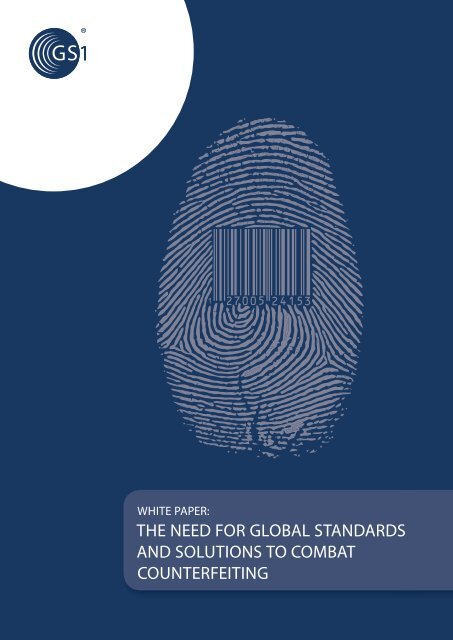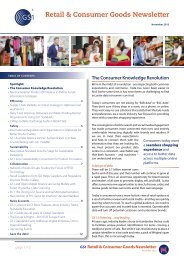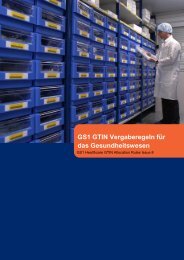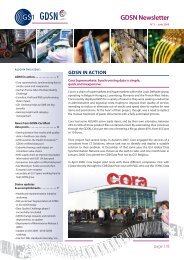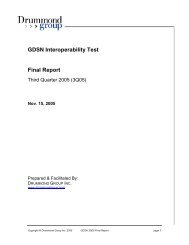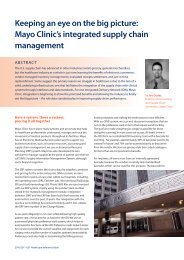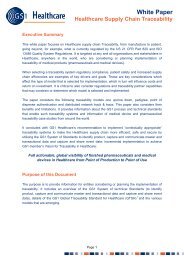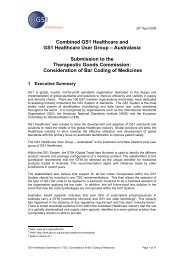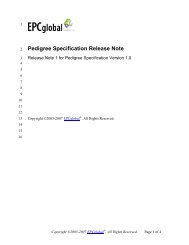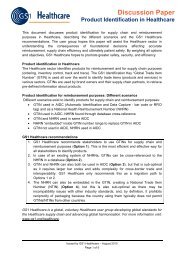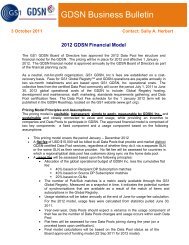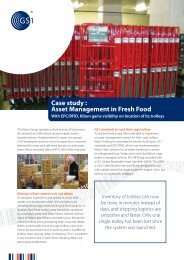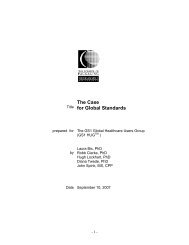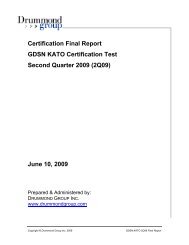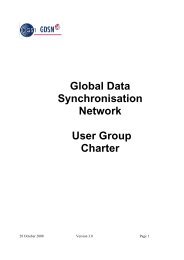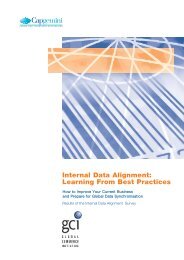the need for global standards and solutions to combat ... - GS1
the need for global standards and solutions to combat ... - GS1
the need for global standards and solutions to combat ... - GS1
You also want an ePaper? Increase the reach of your titles
YUMPU automatically turns print PDFs into web optimized ePapers that Google loves.
WHITE PAPER:<br />
THE NEED FOR GLOBAL STANDARDS<br />
AND SOLUTIONS TO COMBAT<br />
COUNTERFEITING
TABLE OF CONTENTS<br />
1 OVERVIEW 3<br />
2 EXECUTIVE SUMMARY 4<br />
3 THE COUNTERFEIT PROBLEM 7<br />
4 THE SUPPLY CHAIN CHALLENGE 11<br />
5 <strong>GS1</strong> AND ITS ROLE IN SUPPORTING PRODUCT AUTHENTICATION<br />
AND TRACEABILITY SYSTEMS<br />
6 THE <strong>GS1</strong> VISIBILITY FRAMEWORK 19<br />
7 CONCLUSION 22<br />
18
The quest <strong>to</strong> keep harmful products<br />
out of <strong>the</strong> supply chain is a quest <strong>to</strong><br />
protect <strong>the</strong> health of people.<br />
Patients receiving such products<br />
get, at best, bad treatment.<br />
At worst, <strong>the</strong>y can, <strong>and</strong> do, die.<br />
Dr Margaret Chan: Direc<strong>to</strong>r-General of <strong>the</strong> World Health<br />
Organization, 19 November 2012<br />
1 OVERVIEW<br />
The purpose of this whitepaper is <strong>to</strong> provide insights<br />
in<strong>to</strong> <strong>the</strong> increasing threats posed by counterfeit <strong>and</strong> illicit<br />
trade <strong>and</strong> <strong>to</strong> outline how <strong>GS1</strong>’s <strong>global</strong> <strong>st<strong>and</strong>ards</strong>, services<br />
<strong>and</strong> <strong>solutions</strong> can play a vital role in counteracting <strong>the</strong><br />
problem.<br />
The whitepaper highlights key emerging trends <strong>and</strong><br />
deceptive practices <strong>and</strong> outlines how <strong>to</strong> secure <strong>global</strong><br />
supply chains against <strong>the</strong> threats of counterfeit goods<br />
through greater visibility, traceability <strong>and</strong> transparency.<br />
It will fur<strong>the</strong>r explain how existing <strong>GS1</strong> St<strong>and</strong>ards can<br />
assist in reducing <strong>the</strong> threats, helping <strong>to</strong> answer <strong>the</strong><br />
following questions:<br />
• What is <strong>the</strong> business value that will result from<br />
including <strong>GS1</strong> <strong>st<strong>and</strong>ards</strong>, services <strong>and</strong> <strong>solutions</strong><br />
in my br<strong>and</strong> protection strategies?<br />
This whitepaper will help readers underst<strong>and</strong> <strong>the</strong> answers<br />
<strong>to</strong> <strong>the</strong>se questions by:<br />
• Describing <strong>the</strong> <strong>st<strong>and</strong>ards</strong>, processes <strong>and</strong> technologies<br />
that can uniquely identify objects <strong>and</strong> supply chain<br />
activities <strong>to</strong> provide greater visibility <strong>and</strong> traceability<br />
throughout organisations <strong>and</strong> <strong>the</strong>ir extended supply<br />
chains;<br />
• Describing how <strong>st<strong>and</strong>ards</strong>-based approaches enable<br />
more productive, mutually beneficial relationships<br />
among trading partners by enabling more rapid<br />
detection <strong>and</strong> recall of unsafe or counterfeit products;<br />
• Describing an interoperable framework <strong>for</strong> object<br />
identification <strong>and</strong> au<strong>the</strong>ntication services.<br />
• What <strong>st<strong>and</strong>ards</strong>, services <strong>and</strong> <strong>solutions</strong> are<br />
available <strong>to</strong>day?<br />
Overview<br />
3
2 EXECUTIVE SUMMARY<br />
The counterfeit problem<br />
International cooperation <strong>and</strong> a sustained <strong>and</strong> focused<br />
approach is <strong>need</strong>ed <strong>to</strong> tackle <strong>the</strong> rapidly growing counterfeit<br />
trade which is estimated <strong>to</strong> reach USD $1.77 trillion<br />
by 2015 1 . While <strong>the</strong> extent <strong>and</strong> reach of <strong>the</strong> problem<br />
is well unders<strong>to</strong>od, reducing <strong>the</strong> risks <strong>and</strong> impact will<br />
require a <strong>global</strong> collaborative ef<strong>for</strong>t between industry<br />
<strong>and</strong> governments as well as <strong>the</strong> effective deployment of<br />
<strong>global</strong> supply chain <strong>st<strong>and</strong>ards</strong>.<br />
Counterfeiting jeopardises public safety, undermines<br />
legitimate businesses <strong>and</strong> harms national interests:<br />
• The World Health Organization views <strong>the</strong> counterfeit<br />
of medical products as a tremendous risk <strong>to</strong> public<br />
health.<br />
• G20 member countries have an estimated 3,000<br />
deaths annually due <strong>to</strong> counterfeit consumer goods . 1<br />
• Legitimate businesses must compete with counterfeiters<br />
while br<strong>and</strong> owners <strong>and</strong> Intellectual Property<br />
Rights (IPR) holders face significant business <strong>and</strong><br />
fi n a n c i a lr i s k s . 1<br />
Executive Summary<br />
4<br />
• In November 2012, <strong>the</strong> South Korean government<br />
shut down 2 nuclear reac<strong>to</strong>rs 2 after discovering more<br />
than 7,600 parts from 8 suppliers had <strong>for</strong>ged quality<br />
certificates. The two reac<strong>to</strong>rs account <strong>for</strong> about 5% of<br />
South Korea's national power supply. Their suspension<br />
will significantly reduce <strong>the</strong> amount of energy supply<br />
that South Korea holds in reserve each day during<br />
peak winter months in January <strong>and</strong> February.<br />
1 Estimating <strong>the</strong> <strong>global</strong> economic <strong>and</strong> social impacts of counterfeiting <strong>and</strong><br />
piracy. Business Alliance <strong>to</strong> S<strong>to</strong>p Counterfeit <strong>and</strong> Piracy, February 2011<br />
2 http://www.cnn.com/2012/11/05/world/asia/south-korea-nuclearreac<strong>to</strong>rs/index.html<br />
• G20 member countries lose USD $77.5 billion in tax<br />
revenues while incurring an additional USD $25 billion<br />
increased cost of crime. An estimated 2.5 million jobs<br />
have been lost, increasing <strong>the</strong> annual cost of welfare. 1
To a great extent <strong>the</strong> public view of counterfeit products<br />
is one of ambiguity, it is often seen as a victimless crime,<br />
which of course is far from <strong>the</strong> truth. This lack of appreciation<br />
of <strong>the</strong> threat of counterfeits actually encourages <strong>and</strong><br />
supports its continued growth. The three major threats<br />
from counterfeits are:<br />
Counterfeit products are penetrating<br />
in<strong>to</strong> legitimate <strong>and</strong> highly secure<br />
supply chains.<br />
1. Consumer safety is jeopardized through counterfeit<br />
food, medicines, medical devices, <strong>to</strong>ys, consumer<br />
electronics, alcohol, <strong>to</strong>bacco, au<strong>to</strong>motive parts etc.<br />
2. Economic threat impacts business <strong>and</strong> governments –<br />
reducing <strong>the</strong> market <strong>for</strong> legitimate business <strong>and</strong><br />
reducing revenue <strong>for</strong> governments – vat, duties <strong>and</strong><br />
o<strong>the</strong>r taxes while increased cost <strong>for</strong> en<strong>for</strong>cement.<br />
3. National Security is put at risk with counterfeit electronic<br />
components in military <strong>and</strong> defence equipment<br />
poses a national security risk . 3<br />
The increased <strong>global</strong>isation of trade coupled with <strong>the</strong><br />
fact that in many countries <strong>the</strong> penalties <strong>for</strong> trading counterfeit<br />
goods are low or non-existent has encouraged<br />
<strong>the</strong> growth of <strong>global</strong> counterfeit activities, in many cases<br />
operated by criminal gangs <strong>and</strong> terrorists groups.<br />
For <strong>the</strong>se reasons <strong>global</strong> <strong>solutions</strong> are <strong>need</strong>ed <strong>to</strong> address<br />
<strong>the</strong> ever-growing threats presented by this flourishing<br />
criminal activity. In essence, current supply chains are<br />
not fit <strong>for</strong> purpose in terms of <strong>the</strong>ir ability <strong>to</strong> protect <strong>and</strong><br />
detect counterfeit penetration in<strong>to</strong> legitimate <strong>and</strong> secure<br />
supply chains.<br />
Executive Summary<br />
3 http://www.aia-aerospace.org/assets/counterfeit-web11.pdf<br />
5
The Solution<br />
<strong>GS1</strong> is ideally positioned <strong>to</strong> play a key role in <strong>the</strong> development<br />
<strong>and</strong> deployment of Global <strong>st<strong>and</strong>ards</strong>, services<br />
<strong>and</strong> <strong>solutions</strong> <strong>to</strong> <strong>combat</strong> counterfeiting. Solutions <strong>to</strong><br />
counteract <strong>the</strong> growing counterfeit problem <strong>need</strong> <strong>to</strong> be<br />
<strong>global</strong> in nature. This is where <strong>GS1</strong> comes in <strong>and</strong> provides<br />
real <strong>and</strong> immediate answers <strong>to</strong> this growing problem.<br />
<strong>GS1</strong> is <strong>the</strong> only <strong>global</strong> not-<strong>for</strong>-profit organisation assigned<br />
<strong>the</strong> trusted role of Issuing Agency <strong>for</strong> unique object<br />
Identifiers. This vital role is authorized by <strong>the</strong> International<br />
St<strong>and</strong>ards Organization (ISO) who has allocated a block<br />
of Issuing Agency Codes (IAC’s) <strong>to</strong> <strong>GS1</strong> ranging from 0 <strong>to</strong><br />
9. In accordance <strong>to</strong> ISO <strong>st<strong>and</strong>ards</strong>, no o<strong>the</strong>r organisation<br />
shall be allocated this block of unique identifiers. <strong>GS1</strong>’s<br />
role as an Issuing Agency is <strong>to</strong> ensure allocation rules are<br />
defined, identifiers are registered, controlled <strong>and</strong> maintained<br />
<strong>to</strong> ensure <strong>global</strong> uniqueness.<br />
As an Issuing Agency, <strong>GS1</strong> assigns Unique Identification<br />
keys that supports various industries with <strong>global</strong>ly unique<br />
identification of objects including physical goods, logistics<br />
units such as pallets <strong>and</strong> containers, returnable assets,<br />
physical locations, services etc. Upon registration with<br />
<strong>GS1</strong>, a company is assigned a <strong>global</strong>ly unique Company<br />
Prefix (GCP), which allows <strong>the</strong>m <strong>to</strong> create any of <strong>the</strong> <strong>GS1</strong><br />
identification keys in support of <strong>the</strong>ir business <strong>and</strong> supply<br />
chain operations.<br />
The <strong>GS1</strong> Visibility Framework 4 pulls all of this <strong>to</strong>ge<strong>the</strong>r<br />
<strong>and</strong> provides <strong>the</strong> much-<strong>need</strong>ed foundational layers <strong>and</strong><br />
building blocks that allows organisations <strong>to</strong> focus more<br />
on how <strong>to</strong> use <strong>the</strong> in<strong>for</strong>mation ra<strong>the</strong>r than how <strong>to</strong> get <strong>the</strong><br />
in<strong>for</strong>mation. It helps <strong>to</strong> improve collaboration, traceability,<br />
transparency, security, <strong>and</strong> visibility in <strong>the</strong> supply chain.<br />
A key component of <strong>the</strong> Visibility Framework enabling<br />
real-time sharing of supply chain event in<strong>for</strong>mation is <strong>the</strong><br />
application interface st<strong>and</strong>ard called Electronic Product<br />
Code In<strong>for</strong>mation Services 5 (EPCIS), which is both industry<br />
<strong>and</strong> technology neutral. Real-time event management<br />
can play a vital part in helping <strong>to</strong> secure supply chains<br />
<strong>and</strong> reduce <strong>the</strong> risk of counterfeit penetration while<br />
goods are in transit.<br />
Immediate benefits can accrue from <strong>the</strong> usage of existing<br />
<strong>global</strong> <strong>st<strong>and</strong>ards</strong>, services <strong>and</strong> <strong>solutions</strong>. They can be<br />
used by br<strong>and</strong> owners <strong>to</strong> provide cus<strong>to</strong>ms <strong>and</strong> o<strong>the</strong>r<br />
market surveillance authorities with access <strong>to</strong> in<strong>for</strong>mation<br />
which could help <strong>the</strong>m <strong>to</strong> accurately identify objects <strong>and</strong><br />
<strong>the</strong>n route <strong>the</strong>ir verification query <strong>to</strong> <strong>the</strong> authoritative<br />
source <strong>for</strong> fur<strong>the</strong>r au<strong>the</strong>ntication purposes.<br />
Key Concepts<br />
GTIN - Global Trade Item Number<br />
GLN - Global Location Number<br />
SSCC - Serial Shipping Container Code<br />
GRAI - Global Returnable Asset Identifier<br />
GIAI - Global Individual Asset Identifier<br />
GSRN - Global Service Relation Number<br />
GDTI - Global Document Type Identifier<br />
GSIN - Global Shipment Identification Number<br />
GINC - Global Identification Number <strong>for</strong> Consignment<br />
GCN - Global Coupon Number<br />
Executive Summary<br />
6<br />
Essentially <strong>the</strong> <strong>global</strong> solution <strong>to</strong> <strong>the</strong> counterfeit problem<br />
starts with a foundational layer of <strong>global</strong>ly accepted<br />
supply chain <strong>st<strong>and</strong>ards</strong> acting as building blocks <strong>to</strong> identify<br />
objects <strong>and</strong> <strong>the</strong>n <strong>to</strong> capture <strong>the</strong> in<strong>for</strong>mation about<br />
<strong>the</strong>m at key points in <strong>the</strong> supply chain <strong>and</strong> <strong>the</strong>n <strong>to</strong> share<br />
<strong>the</strong> in<strong>for</strong>mation seamlessly among stakeholders.<br />
4 http://www.gs1.org/visibility<br />
5 http://www.gs1.org/gsmp/kc/epc<strong>global</strong>/epcis
3 THE COUNTERFEIT PROBLEM<br />
Counterfeiting has changed from being largely localised<br />
operations in<strong>to</strong> highly profitable <strong>global</strong> businesses with<br />
mass production, <strong>global</strong> sales, <strong>and</strong> complex <strong>global</strong> distribution<br />
networks. Counterfeit physical objects can be<br />
found in almost every country <strong>and</strong> in virtually all sec<strong>to</strong>rs<br />
of <strong>the</strong> <strong>global</strong> economy.<br />
Counterfeits are often subst<strong>and</strong>ard <strong>and</strong> can pose serious<br />
health <strong>and</strong> safety risks, with an estimated 3,000 deaths<br />
annually in <strong>the</strong> G20 member economies. In 2011, <strong>the</strong><br />
Paris-based Business Alliance <strong>to</strong> S<strong>to</strong>p Counterfeit <strong>and</strong><br />
Piracy (BASCAP) estimated that <strong>the</strong> counterfeit <strong>and</strong> piracy<br />
market is growing annually at 22%.<br />
According <strong>to</strong> BASCAP counterfeiting <strong>and</strong> piracy impact<br />
virtually every product category. The days when only luxury<br />
goods were counterfeited, or when unauthorized music<br />
CDs <strong>and</strong> movie DVDs were sold only on street corners are<br />
long past. Today, counterfeiters are producing fake foods,<br />
beverages, pharmaceuticals, medical devices, electronics,<br />
semi-conduc<strong>to</strong>rs, electrical goods <strong>and</strong> supplies, au<strong>to</strong> <strong>and</strong><br />
airplane parts as well as everyday household products.<br />
Millions of fake products are being produced <strong>and</strong> shipped<br />
around <strong>the</strong> world <strong>to</strong> developing <strong>and</strong> developed markets<br />
alike at increasing rates, penetrating legitimate <strong>and</strong> secure<br />
supply chains. Consumers <strong>and</strong> patients are at risk from<br />
The Counterfeit Problem<br />
7
Table 1. The Complete Picture<br />
Estimate of <strong>the</strong> <strong>to</strong>tal value of counterfeit <strong>and</strong> pirated products in 2008 <strong>and</strong> 2015, <strong>and</strong> impacts on <strong>the</strong> broader economy <strong>and</strong> employment.<br />
Source: Frontier Economics<br />
OECD Category<br />
OECD Estimate in<br />
$ billions (2008)<br />
BASCAP Estimate in<br />
$ billions (2015)<br />
Internationally traded counterfeit <strong>and</strong> pirated products $285 - $360 $770 - $960<br />
Domestically produced <strong>and</strong> consumed counterfeit<br />
<strong>and</strong> pirated products<br />
$140 - $215 $370 - $570<br />
Digitally pirated products $30 - $75 $80 - $240<br />
Sub <strong>to</strong>tal $455 - $650 $1,220 - $1,770<br />
Broader economy wide effects * $125 $125 +<br />
Employment losses** 2.5 million 2.5 million +<br />
* Effects on government tax revenues, welfare spending, costs of crime health services, FDI flows<br />
** Estimate limited <strong>to</strong> G20 economies<br />
unsafe <strong>and</strong> ineffective products, while governments,<br />
businesses <strong>and</strong> society are being robbed of billions in tax<br />
revenues, income <strong>and</strong> jobs.<br />
The Counterfeit Problem<br />
The drain on <strong>the</strong> <strong>global</strong> economy is significant <strong>and</strong> <strong>the</strong><br />
longer-term implications of <strong>the</strong> continuing growth in<br />
this illicit trade are enormous. In 2008 <strong>the</strong> OECD has<br />
reported that “international trade in counterfeit <strong>and</strong><br />
pirated products could be up <strong>to</strong> US$ 360 billion”. Taken<br />
<strong>to</strong>ge<strong>the</strong>r with <strong>the</strong> value of domestically produced <strong>and</strong><br />
consumed counterfeits, <strong>the</strong> significant volume of digital<br />
<strong>and</strong> fake products being distributed via <strong>the</strong> Internet, <strong>and</strong><br />
<strong>the</strong> loss of economic development, harm <strong>to</strong> health <strong>and</strong><br />
safety, reduced technology transfer, <strong>and</strong> innovation, <strong>the</strong><br />
<strong>to</strong>tal magnitude of counterfeiting <strong>and</strong> piracy worldwide<br />
is estimated <strong>to</strong> be well over US$650 billion. The BASCAP<br />
report has used <strong>the</strong> OECD 2008 analysis <strong>and</strong> estimated<br />
<strong>the</strong> 2015 impact of USD 1.77 trillion.<br />
A disorder of this magnitude undermines economic<br />
development, a sound market economy system <strong>and</strong> open<br />
international trade <strong>and</strong> investment. No legitimate business<br />
<strong>and</strong> no country is immune 6 <strong>to</strong> <strong>the</strong> impact of counterfeit<br />
<strong>and</strong> piracy. No single business, business sec<strong>to</strong>r or country<br />
can fight this battle alone.<br />
6 http://www.chamber.ca/images/uploads/Reports/2012/120607CIPC_<br />
Counterfeiting.pdf<br />
In order <strong>to</strong> ground this discussion we have chosen <strong>to</strong> look<br />
briefly at a sec<strong>to</strong>r which more than any o<strong>the</strong>r has been<br />
sucessfully targeted by counterfeiters with dangerous<br />
consequence <strong>for</strong> patients <strong>and</strong> serious impact on <strong>the</strong> legitimate<br />
manufacturers of br<strong>and</strong>ed <strong>and</strong> generic medicines.<br />
8
The link between pharmaceutical<br />
counterfeiting,<br />
crime <strong>and</strong> national security<br />
The World Health Organisation (WHO) views <strong>the</strong> counterfeiting<br />
of medical products as a tremendous risk <strong>to</strong> public<br />
health. Pharmaceuticals purchased over <strong>the</strong> Internet are<br />
from sites that conceal <strong>the</strong>ir physical address are counterfeit<br />
in over 50% of cases. 7 While <strong>the</strong> risk of counterfeit<br />
medicines is low in developed countries, it remains a<br />
major <strong>global</strong> issue costing <strong>the</strong> pharmaceutical industry<br />
billion of dollars <strong>and</strong> <strong>the</strong> innocent people who take <strong>the</strong>m<br />
<strong>the</strong>ir health or lives. 8<br />
The deadly implications of counterfeit drugs are well<br />
unders<strong>to</strong>od <strong>to</strong> be a central challenge <strong>to</strong> <strong>the</strong> integrity<br />
of public health systems around <strong>the</strong> globe, as well as a<br />
direct threat <strong>to</strong> our individual health <strong>and</strong> welfare. What is<br />
less unders<strong>to</strong>od is that <strong>the</strong> profits from this sinister crime<br />
are increasingly being co-opted by an array of organized<br />
criminal groups 9 <strong>and</strong> terrorist entities as a means by<br />
which <strong>to</strong> fund <strong>the</strong>ir operations around <strong>the</strong> world. As<br />
such, counterfeit pharmaceuticals pose a direct threat <strong>to</strong><br />
national <strong>and</strong> international security.<br />
Combating <strong>the</strong> sale of<br />
illegal medicines online<br />
Operation Pangea 10 is an international week of action<br />
tackling <strong>the</strong> online sale of counterfeit <strong>and</strong> illicit medicines<br />
<strong>and</strong> highlighting <strong>the</strong> dangers of buying medicines online.<br />
Coordinated by INTERPOL, <strong>the</strong> annual operation brings<br />
<strong>to</strong>ge<strong>the</strong>r cus<strong>to</strong>ms, health regula<strong>to</strong>rs, national police <strong>and</strong><br />
<strong>the</strong> private sec<strong>to</strong>r from countries around <strong>the</strong> world.<br />
Activities target <strong>the</strong> three principal components used by<br />
illegal websites <strong>to</strong> conduct <strong>the</strong>ir trade – <strong>the</strong> Internet Service<br />
Provider (ISP), payment systems <strong>and</strong> <strong>the</strong> delivery service.<br />
The operation has gained significant momentum since<br />
its launch in 2008. The first phase of <strong>the</strong> operation brought<br />
<strong>to</strong>ge<strong>the</strong>r 10 countries, with <strong>the</strong> number rising <strong>to</strong> 100 in 2012.<br />
Results from Pangea V from September 25 th <strong>to</strong> Oc<strong>to</strong>ber<br />
2 nd 2012:<br />
• 3.75 million illicit <strong>and</strong> counterfeit pills confiscated;<br />
• Estimated value: USD 10.5 million;<br />
• More than 18,000 websites shut down;<br />
7 http://www.who.int/bulletin/volumes/88/4/10-020410/en/index.html<br />
8 http://www.worldfinance.com/home/special-reports-home/<br />
trade-in-illegal-medicine-hits-pharmaceutical-sec<strong>to</strong>r<br />
9 http://www.interpol.int/Crime-areas/Pharmaceutical-crime/<br />
Pharmaceutical-crime<br />
10 http://www.interpol.int/Crime-areas/Pharmaceutical-crime/Operations/<br />
Operation-Pangea<br />
The Counterfeit Problem<br />
9
Trends in Counterfeiting<br />
<strong>and</strong> Deceptive Practices<br />
Counterfeiters will use every means possible <strong>to</strong> deceive<br />
authorities <strong>and</strong> <strong>the</strong>ir cus<strong>to</strong>mers. The following are known<br />
trends <strong>and</strong> deceptive practices. 12<br />
Trends <strong>and</strong> Deceptive practices<br />
• Unbr<strong>and</strong>ed physical objects are shipped separately<br />
from <strong>the</strong>ir labels, insignia <strong>and</strong> br<strong>and</strong> packaging.<br />
• Counterfeiters specialising in producing ei<strong>the</strong>r counterfeit<br />
labels, insignia or consumer packaging export<br />
<strong>the</strong>se products <strong>to</strong> assemblers who complete <strong>the</strong> final<br />
assembly of <strong>the</strong> counterfeit objects.<br />
• 133,000 packages inspected by regula<strong>to</strong>rs <strong>and</strong><br />
cus<strong>to</strong>ms authorities, of which around 6,700 were<br />
confiscated;<br />
• 80 individuals are currently under investigation or<br />
under arrest <strong>for</strong> a range of offences, including operating<br />
a cl<strong>and</strong>estine labora<strong>to</strong>ry producing counterfeit<br />
medicines; membership of a criminal group selling<br />
illicit medicine online; <strong>and</strong> operating websites selling<br />
illicit medicines.<br />
• Counterfeit components or sub-assemblies are<br />
shipped separately <strong>to</strong> Free Trade Zones (FTZ) <strong>to</strong> be<br />
assembled <strong>and</strong> distributed within <strong>the</strong> FTZ or <strong>to</strong> countries<br />
outside <strong>the</strong> FTZ.<br />
• FTZs are used <strong>to</strong> mask <strong>the</strong> origin of counterfeits<br />
• Part of a genuine shipment or container/pallet of<br />
goods are replaced with counterfeits (i.e. genuine <strong>and</strong><br />
counterfeit co-mingled).<br />
The Counterfeit Problem<br />
10<br />
The usage of <strong>GS1</strong> St<strong>and</strong>ards, Services <strong>and</strong> Solutions could<br />
assist in building <strong>the</strong> very basic level of trust between<br />
buyers <strong>and</strong> sellers online. Trust can be added with verifiable<br />
source in<strong>for</strong>mation about <strong>the</strong> seller, <strong>the</strong> products<br />
<strong>and</strong> methods <strong>to</strong> au<strong>the</strong>nticate <strong>the</strong> products once received<br />
by <strong>the</strong> buyer.<br />
Continued growth in <strong>the</strong> online sales<br />
of pirated <strong>and</strong> counterfeit hard goods<br />
will soon surpass <strong>the</strong> volume of such<br />
goods sold by street vendors <strong>and</strong> in<br />
o<strong>the</strong>r physical markets. 11<br />
11 The AMR Research study, "Traceability in <strong>the</strong> Food <strong>and</strong> Beverage Supply<br />
Chain," conducted by Research Direc<strong>to</strong>rs Lora Cecere <strong>and</strong> Lucie Draper,<br />
<strong>and</strong> Senior Research Analyst Simon Jacobson<br />
• Sales on <strong>the</strong> Internet of counterfeit goods indicated as<br />
excess, over-s<strong>to</strong>ck or returns.<br />
• Consumer-<strong>to</strong>-consumer (C2C) sales of counterfeit<br />
products take place both online <strong>and</strong> offline.<br />
• Differences <strong>and</strong> gaps in local laws, regulations <strong>and</strong><br />
en<strong>for</strong>cement ability are taken advantage of <strong>to</strong> keep as<br />
many stages of counterfeit activities from being shut<br />
down <strong>for</strong> as long as possible, exposing lower-level<br />
traffickers <strong>to</strong> legal ramifications.<br />
• Increasing use of <strong>the</strong> Internet as a sales channel.<br />
• Increasing use of legitimate courier <strong>and</strong> regular<br />
post <strong>for</strong> small packages, making it more difficult <strong>for</strong><br />
en<strong>for</strong>cement <strong>to</strong> curtail such activity. 13<br />
12 http://www.ustr.gov/about-us/press-office<br />
reports-<strong>and</strong>-publications/2012-2<br />
13 http://www.chamber.ca/images/uploads/Reports/2012/120607CIPC_<br />
Counterfeiting.pdf
4 THE SUPPLY CHAIN CHALLENGE<br />
Current Supply Chain<br />
Overview<br />
The existing supply chain in many sec<strong>to</strong>rs is not fit <strong>for</strong><br />
purpose in terms of its ability <strong>to</strong> cope with <strong>the</strong> challenge<br />
of <strong>the</strong> growing counterfeit problem. The shortcomings<br />
are due <strong>to</strong> <strong>the</strong> fact that current supply chain processes<br />
are based on legacy systems, which in <strong>the</strong> past were<br />
heavily dependent on paperflows. Although <strong>the</strong>re has<br />
been adoption of AIDC (ie. <strong>the</strong> barcode or RFID tag) <strong>and</strong><br />
EDI technologies, <strong>the</strong> <strong>solutions</strong> deployed, with some<br />
notable exceptions, have not included <strong>global</strong> <strong>st<strong>and</strong>ards</strong><br />
<strong>for</strong> unique object identification, traceability <strong>and</strong> event<br />
management as core components <strong>and</strong> <strong>the</strong>re<strong>for</strong>e visibility<br />
across <strong>the</strong> extended supply chain is often low.<br />
The evidence <strong>to</strong> support this is <strong>the</strong> poor recall capability<br />
of US <strong>and</strong> EU food manufacturing companies as reported<br />
by AMR Research in 2007. 13 The research found that 67%<br />
of Food Companies with USD$5 billion or more in sales<br />
had recalls that cost USD$20 million or more, that it <strong>to</strong>ok<br />
on average of 42 days <strong>to</strong> complete <strong>the</strong> recall process<br />
<strong>and</strong> that at best <strong>the</strong>y could only locate 43% of affected<br />
products in <strong>the</strong> most serious category of recall. Counterfeit<br />
products can be <strong>the</strong> cause of a serious recall - given<br />
this reality it spells out <strong>the</strong> <strong>need</strong> <strong>for</strong> greater transparency<br />
The Supply Chain Challenge<br />
11
<strong>and</strong> visibility of supply chains in order <strong>to</strong> enable effective<br />
object identification <strong>and</strong> au<strong>the</strong>ntication processes <strong>to</strong><br />
counteract <strong>the</strong> increasing threat from counterfeiters.<br />
<strong>GS1</strong> <strong>and</strong> industry worked on solving this problem <strong>and</strong> a<br />
new <strong>global</strong> messaging st<strong>and</strong>ard <strong>for</strong> product recall was<br />
ratified in June 2012. 14 The accompanying online recall<br />
notification service operated by <strong>GS1</strong> organizations on<br />
behalf of industry in USA 15 , Canada 16 , Australia 17 , New<br />
Zeal<strong>and</strong> 18 <strong>and</strong> South Africa 19 reduces <strong>the</strong> critical time <strong>to</strong><br />
communicate <strong>the</strong> recall or safety alert <strong>to</strong> all supply chain<br />
stakeholders including government <strong>to</strong> less than 1 hour.<br />
The st<strong>and</strong>ard <strong>and</strong> <strong>the</strong> services taken <strong>to</strong>ge<strong>the</strong>r, reduce risks<br />
<strong>to</strong> business <strong>and</strong> <strong>to</strong> consumer safety.<br />
Proprietary <strong>solutions</strong><br />
are not <strong>the</strong> answer<br />
In recent years numerous proprietary <strong>solutions</strong> <strong>for</strong> object<br />
identification, au<strong>the</strong>ntication <strong>and</strong> secure supply chains<br />
have been developed mainly in isolation from each o<strong>the</strong>r.<br />
They lack <strong>the</strong> critical interoperability required <strong>to</strong> ensure<br />
that all supply chain partners can readily deploy <strong>the</strong>m.<br />
In particular, <strong>to</strong> be effective across <strong>the</strong> he multi-tier<br />
supply chain it is vital that all parties have a common<br />
<strong>global</strong>ly unique object identification <strong>and</strong> data sharing<br />
st<strong>and</strong>ard which can be easily managed within <strong>the</strong>ir<br />
internal systems <strong>and</strong> with <strong>the</strong>ir trading partners.<br />
What is <strong>need</strong>ed <strong>the</strong>n <strong>to</strong><br />
address <strong>the</strong> challenge?<br />
The answer is enhanced supply chain visibility with<br />
improved traceability <strong>and</strong> transparency along <strong>the</strong> entire<br />
supply chain <strong>and</strong>, most importantly, <strong>solutions</strong> that are<br />
based on open, interoperable <strong>global</strong> <strong>st<strong>and</strong>ards</strong> which<br />
facilitate widespread <strong>and</strong> cost effective deployment.<br />
Fortunately, <strong>GS1</strong>’s <strong>global</strong> identification system<br />
includes <strong>global</strong>ly unique identification <strong>for</strong> products,<br />
assets (objects) <strong>and</strong> locations as well as its <strong>st<strong>and</strong>ards</strong><br />
<strong>for</strong> capturing <strong>and</strong> sharing visibility <strong>and</strong> traceability<br />
data between supply chain partners <strong>and</strong> o<strong>the</strong>r key<br />
stakeholders.<br />
This foundational level of identification <strong>st<strong>and</strong>ards</strong> is<br />
ideally suited <strong>to</strong> supporting <strong>solutions</strong> which are <strong>need</strong>ed<br />
<strong>to</strong> secure supply chains <strong>and</strong> provide effective means of<br />
identifying <strong>and</strong> au<strong>the</strong>nticating an object in real-time in<br />
order <strong>to</strong> ensure that counterfeits are detected be<strong>for</strong>e <strong>the</strong>y<br />
cause harm <strong>to</strong> consumer, businesses or national interests.<br />
The <strong>GS1</strong> Visibility Framework discussed in more detail<br />
in section 6, combined with o<strong>the</strong>r process <strong>st<strong>and</strong>ards</strong>,<br />
such as <strong>the</strong> <strong>GS1</strong> Traceability St<strong>and</strong>ard (GTS) <strong>and</strong> <strong>the</strong> business-messaging<br />
st<strong>and</strong>ard <strong>for</strong> Product Recall, become very<br />
powerful <strong>to</strong>ols <strong>to</strong> enable safe <strong>and</strong> secure supply chains.<br />
While <strong>the</strong>re is no single method <strong>to</strong> guarantee <strong>the</strong> identity<br />
<strong>and</strong> au<strong>the</strong>nticity of physical objects across industries,<br />
unique object identification coupled with added security<br />
deterrents is a requirement in certain industry sec<strong>to</strong>rs. But<br />
<strong>the</strong>se are components of a much wider br<strong>and</strong> protection<br />
strategy.<br />
The Supply Chain Challenge<br />
12<br />
14 http://www.gs1.org/docs/media_centre/gs1_pr_139612_product_recall.pdf<br />
15 http://www.rapidrecallexchange.org/About/tabid/56/Default.aspx<br />
16 http://www.gs1ca.org/page.asp?LSM=0&intPageID=1395<br />
17 http://www.gs1au.org/services/recallnet/<br />
18 http://www.gs1nz.org/productrecallnz.php<br />
19 Soft launch December 2012 with <strong>for</strong>mal launch in June 2013.<br />
<strong>GS1</strong> Barcode <strong>and</strong> <strong>GS1</strong> object identifier or GTIN (Figure 1)
Safe & Secure Supply Chains<br />
Developing <strong>and</strong> deploying safe <strong>and</strong> secure supply chains<br />
is critical not only <strong>to</strong> mitigate <strong>the</strong> risk of counterfeits, but<br />
<strong>to</strong> increase trust <strong>and</strong> transparency in<strong>to</strong> trading partner<br />
relationships. The foundation layer <strong>for</strong> building safe <strong>and</strong><br />
secure supply chains can be effectively addressed by<br />
deploying <strong>the</strong> <strong>GS1</strong> Visibility Framework discussed later in<br />
this document <strong>and</strong> also available as a whitepaper. 20<br />
The <strong>GS1</strong> Visibility Framework takes a comprehensive<br />
approach based on all key aspects highlighted in Figure<br />
2 below <strong>and</strong> includes real-time event management <strong>and</strong><br />
traceability.<br />
This whitepaper focus briefly on aspects of Au<strong>the</strong>ntication,<br />
namely Object Identity <strong>and</strong> Object Au<strong>the</strong>ntication.<br />
Safe <strong>and</strong> secure supply chain framework<br />
(Figure 2)<br />
Safe & Secure<br />
Supply Chain<br />
Is <strong>the</strong> Object Genuine?<br />
Is <strong>the</strong> chain of cus<strong>to</strong>dy intact?<br />
Au<strong>the</strong>ntication<br />
Pedigree 22<br />
Object Identity Object Au<strong>the</strong>ntication Track Trace<br />
Is <strong>the</strong> Object<br />
identifier valid?<br />
Industry Use Case:<br />
Does <strong>the</strong> Object have <strong>the</strong><br />
expected covert <strong>and</strong>/or<br />
overt security features?<br />
Where is <strong>the</strong> Object <strong>and</strong><br />
where is it headed?<br />
Where was <strong>the</strong> Object?<br />
(Locations&Cus<strong>to</strong>dians)<br />
The EU Falsified Medicines Directive which seeks <strong>to</strong><br />
have a more secure supply chain <strong>for</strong> <strong>the</strong> distribution of<br />
prescribed medicines requires serialisation of patient<br />
packs as well as tamper evident labelling <strong>to</strong> enable<br />
au<strong>the</strong>ntication of medicines prior <strong>to</strong> <strong>the</strong>ir being<br />
dispensed <strong>to</strong> patients. EFPIA (<strong>the</strong> European Federation of<br />
Pharmaceutical Industry Associations) has developed <strong>and</strong><br />
successfully piloted an au<strong>the</strong>ntication solution based on<br />
<strong>GS1</strong> au<strong>to</strong>matic identification <strong>and</strong> data capture <strong>st<strong>and</strong>ards</strong><br />
as well as <strong>the</strong> use of EPCIS <strong>for</strong> <strong>the</strong> operation of a federated<br />
database which ensures that a retail pharmacy can<br />
check <strong>the</strong> au<strong>the</strong>nticity of a medicine be<strong>for</strong>e dispensing<br />
<strong>to</strong> a patient. In January 2012, <strong>GS1</strong> <strong>global</strong> office <strong>and</strong> <strong>the</strong><br />
EFPIA issued a joint vision statement <strong>for</strong> achieving <strong>the</strong> EU<br />
regula<strong>to</strong>ry requirements. 21<br />
A practical example of real supply chain visibility, albeit<br />
on a small scale, is already working since 2005 <strong>and</strong> has<br />
demonstrated <strong>the</strong> ability <strong>to</strong> au<strong>the</strong>nticate a product<br />
20 http://www.gs1.org/docs/<strong>GS1</strong>_SupplyChainVisibility_WhitePaper.pdf<br />
21 http://www.gs1.org/docs/healthcare/<strong>GS1</strong>-EFPIA_product_identification_vision_background.pdf<br />
prior <strong>to</strong> use <strong>and</strong> ensure a <strong>to</strong>tal recall of products across<br />
more than two hundred locations within 10 minutes.<br />
The NCHCD (National Centre <strong>for</strong> Hereditary Coagulation<br />
Disorders), which has responsibility <strong>for</strong> <strong>the</strong> safe treatment<br />
of haemophilia patients in Irel<strong>and</strong> has achieved 100%<br />
compliance with National <strong>and</strong> EU regulations. Fur<strong>the</strong>rmore<br />
<strong>the</strong> solution although originally implemented only<br />
<strong>for</strong> patient safety <strong>and</strong> compliance reasons has resulted in<br />
very significant financial savings including an annual ROI<br />
of more than 100%, a reduction in s<strong>to</strong>ck levels of €5m,<br />
<strong>and</strong> o<strong>the</strong>r benefits.<br />
In Oc<strong>to</strong>ber 2012, McKinsey published a comprehensive<br />
report highlighting <strong>the</strong> value of <strong>global</strong> <strong>st<strong>and</strong>ards</strong> in <strong>the</strong><br />
healthcare supply chain. A copy of <strong>the</strong> report can be<br />
found at http://www.gs1.org/docs/healthcare/McKinsey_<br />
Healthcare_Report_Strength_in_Unity.pdf<br />
The following section will explore Object Identity <strong>and</strong><br />
Object Au<strong>the</strong>ntication briefly.<br />
22 http://www.gs1.org/gsmp/kc/epc<strong>global</strong>/pedigree<br />
The Supply Chain Challenge<br />
13
The Supply Chain Challenge<br />
Object Identity -<br />
which object <strong>and</strong> what is it?<br />
Object identity at <strong>the</strong> consumer <strong>and</strong> retail level:<br />
At <strong>the</strong> retail level, <strong>the</strong> process <strong>to</strong> verify an objects identity<br />
such as a consumer product should start with <strong>the</strong> physical<br />
<strong>and</strong> visual inspection of <strong>the</strong> object itself. The integrity of<br />
<strong>the</strong> outer packaging <strong>and</strong> <strong>the</strong> presence of br<strong>and</strong> insignia,<br />
labels including a barcode with GTIN are vital clues <strong>to</strong><br />
aid in <strong>the</strong> object verification process. A consumer should<br />
normally direct queries <strong>to</strong> <strong>the</strong> retailer be<strong>for</strong>e purchasing a<br />
product. With online purchasing <strong>and</strong> gifts, this process is<br />
not always possible <strong>and</strong> <strong>the</strong> consumer may <strong>need</strong> additional<br />
<strong>to</strong>ols <strong>to</strong> verify <strong>the</strong> identify <strong>and</strong> au<strong>the</strong>nticity of <strong>the</strong> product.<br />
A consumer should always try <strong>to</strong> contact <strong>the</strong> br<strong>and</strong> owner<br />
through a verified website or cus<strong>to</strong>mer service phone<br />
number if any doubt exists about <strong>the</strong> object.<br />
Many st<strong>and</strong>alone websites <strong>and</strong> smart phone applications<br />
exist <strong>to</strong>day that claim <strong>to</strong> provide in<strong>for</strong>mation about products<br />
including product descriptions, features, nutritional<br />
in<strong>for</strong>mation, pricing etc. etc. However, many of <strong>the</strong>se<br />
sources may not be linked <strong>to</strong> <strong>the</strong> trusted product master<br />
data owner 23 by <strong>the</strong> product br<strong>and</strong> owner. Recent studies<br />
have highlighted that <strong>the</strong> accuracy of mobile scans <strong>for</strong><br />
product in<strong>for</strong>mation is very low. <strong>GS1</strong> is working with<br />
industry <strong>to</strong> solve this problem with <strong>GS1</strong> Source.<br />
<strong>GS1</strong> Source is a framework <strong>for</strong> sharing product in<strong>for</strong>mation<br />
in consumer-facing digital channels. It is <strong>st<strong>and</strong>ards</strong>-based,<br />
scalable <strong>and</strong> interoperable. Companies can<br />
use <strong>GS1</strong> Source <strong>to</strong> share in<strong>for</strong>mation about <strong>the</strong>ir products<br />
in <strong>the</strong> cloud. Application developers can <strong>the</strong>n integrate<br />
this product data in <strong>the</strong>ir web <strong>and</strong> mobile applications.<br />
In 2012, <strong>GS1</strong> ratified it’s Trusted Source of Data (TSD) 1.0<br />
St<strong>and</strong>ard. 24<br />
Object Identify <strong>for</strong> Cus<strong>to</strong>ms <strong>and</strong> Market Surveillance:<br />
If a cus<strong>to</strong>ms officer or market surveillance agent has a<br />
consumer product, box of products, a pallet of goods<br />
or container with several pallets under review or inspection,<br />
<strong>the</strong> agent may <strong>need</strong> <strong>to</strong> find “identity” in<strong>for</strong>mation<br />
about <strong>the</strong> products <strong>and</strong> shipment. This can be achieved<br />
by using <strong>GS1</strong>’s Global Electronic Product In<strong>for</strong>mation<br />
Registry or GEPIR www.gepir.org<br />
GEPIR is a unique, internet-based service that gives<br />
access <strong>to</strong> basic contact in<strong>for</strong>mation <strong>for</strong> companies that<br />
are members of <strong>GS1</strong>. These member companies use<br />
<strong>GS1</strong>’s <strong>global</strong>ly unique numbering system <strong>to</strong> identify<br />
<strong>the</strong>ir products, physical locations, or shipments. By using<br />
<strong>the</strong> in<strong>for</strong>mation on <strong>the</strong> product or its’ packaging, <strong>and</strong><br />
typing <strong>the</strong> numbers in<strong>to</strong> GEPIR, anyone can find <strong>the</strong><br />
14<br />
23 http://www.gs1.org/docs/gdsn/gdsn_brochure.pdf 24 http://www.gs1.org/source/about
legally registered owner of that barcode identifier <strong>and</strong><br />
<strong>the</strong>ir contact in<strong>for</strong>mation. Physical location numbers such<br />
as GLN’s <strong>and</strong> Serialized Shipping Container Codes (SSCC’s)<br />
can also be used as search criteria.<br />
This is <strong>the</strong> first <strong>and</strong> arguably <strong>the</strong> most critical phase of<br />
object au<strong>the</strong>ntication.<br />
Reasons why <strong>the</strong> object identifier would not appear on<br />
GEPIR includes:<br />
• Incorrectly entered Object Identifier.<br />
• Illegal usage of <strong>the</strong> Object Identifier – company using<br />
<strong>GS1</strong> system but not registered.<br />
• Object Identifier on a secondary label on <strong>the</strong> object or<br />
packaging <strong>and</strong> was assigned by <strong>the</strong> importer who is<br />
not registered with <strong>GS1</strong>.<br />
• Counterfeit or fake Object Identifier – GEPIR may return<br />
a different company than that on <strong>the</strong> object. The br<strong>and</strong><br />
owners website or cus<strong>to</strong>mer service should be contacted<br />
ASAP if doubt exists about <strong>the</strong> identity of <strong>the</strong> physical<br />
object under review or inspection. Br<strong>and</strong> owners will<br />
generally have multiple br<strong>and</strong>s within <strong>the</strong>ir portfolios.<br />
• National security <strong>and</strong> privacy – manufacturers may<br />
be subject <strong>to</strong> national security or privacy guidelines<br />
<strong>and</strong> <strong>the</strong>ir product <strong>and</strong>/or company details may not be<br />
available online.<br />
<strong>GS1</strong>’s <strong>global</strong> <strong>st<strong>and</strong>ards</strong> also defined a Global Product<br />
Classification Code 25 or GPC. GPC is a structured; rules<br />
based classification system that gives buyers <strong>and</strong> sellers<br />
a common language <strong>for</strong> grouping products in <strong>the</strong> same<br />
way, everywhere in <strong>the</strong> world. The official (normative)<br />
GPC schema <strong>and</strong> GPC Browser in<strong>for</strong>mation is published in<br />
Ox<strong>for</strong>d English. Both <strong>the</strong> schema <strong>and</strong> <strong>the</strong> browser in<strong>for</strong>mation<br />
are translated <strong>to</strong> o<strong>the</strong>r languages.<br />
GPC is an invaluable <strong>to</strong>ol <strong>for</strong> br<strong>and</strong> owners <strong>to</strong> categorize,<br />
register <strong>and</strong> share object master data with all trading<br />
parties. It can also be utilized by market surveillance <strong>to</strong><br />
verify object identity <strong>and</strong> by cus<strong>to</strong>ms <strong>for</strong> pre-import risk<br />
assessment. One government agency assessment of an<br />
objects GTIN plus it’s GPC highlighted a potential 80%<br />
reduction in import holds while freeing up officers <strong>for</strong><br />
more targeted inspections of high risk goods.<br />
The Supply Chain Challenge<br />
25 http://www.gs1.org/gdsn/gpc/what<br />
15
Object Au<strong>the</strong>ntication –<br />
is it genuine?<br />
Br<strong>and</strong> owners may provide various online, mobile, field<br />
or lab based applications <strong>and</strong> <strong>to</strong>ols specifically <strong>for</strong> <strong>the</strong><br />
purposes of au<strong>the</strong>nticating a product. After verifying <strong>the</strong><br />
object identity, <strong>the</strong> next step is <strong>to</strong> determine if <strong>the</strong> object<br />
is genuine.<br />
Au<strong>the</strong>ntication of an object will depend on who is in<br />
<strong>the</strong> role of <strong>the</strong> object inspec<strong>to</strong>r <strong>and</strong> <strong>the</strong>ir knowledge of<br />
<strong>the</strong> product (object) <strong>and</strong> its au<strong>the</strong>ntication process <strong>and</strong><br />
procedure. The inspec<strong>to</strong>r may have access <strong>to</strong> very limited<br />
or very detailed br<strong>and</strong> protection in<strong>for</strong>mation, which may<br />
be simple or complex; depending on <strong>the</strong> objects value,<br />
complexity <strong>and</strong> intended usage.<br />
Consumers: a consumer in <strong>the</strong> role of object inspec<strong>to</strong>r<br />
will generally rely on his or her own knowledge of a<br />
product (object) <strong>and</strong> a visual inspection <strong>to</strong> verify if it is<br />
genuine be<strong>for</strong>e a purchase. Consumers generally trust <strong>the</strong><br />
retailer where <strong>the</strong>y purchase <strong>the</strong> product <strong>to</strong> ensure that it<br />
is safe <strong>and</strong> au<strong>the</strong>ntic.<br />
Cus<strong>to</strong>ms or Market Surveillance Authorities:<br />
in <strong>the</strong>se roles, cus<strong>to</strong>ms or market surveillance may have<br />
access <strong>to</strong> limited or very detailed confidential in<strong>for</strong>mation<br />
sources, typically a confidential portal which lists <strong>and</strong><br />
describes <strong>the</strong> various br<strong>and</strong> protection strategies <strong>for</strong> a<br />
particular object. The br<strong>and</strong> protection strategies can<br />
have multiple verification <strong>to</strong>ols that are required <strong>to</strong> verify<br />
<strong>the</strong> au<strong>the</strong>nticity of an object:<br />
Key questions <strong>for</strong> cus<strong>to</strong>ms or market surveillance include:<br />
Does <strong>the</strong> physical object have <strong>the</strong> expected digital,<br />
covert <strong>and</strong>/or overt deterrents <strong>to</strong> prove au<strong>the</strong>nticity?<br />
Who is <strong>the</strong> authoritative <strong>and</strong> trusted source <strong>to</strong> verify <strong>the</strong><br />
object’s au<strong>the</strong>nticity?<br />
Methods commonly used <strong>for</strong> Object Au<strong>the</strong>ntication<br />
(Figure 3)<br />
Extrinsic Au<strong>the</strong>ntication Tools<br />
Added <strong>for</strong> <strong>the</strong> primary purpose of<br />
au<strong>the</strong>ntication<br />
Sensory <strong>to</strong>ols<br />
• Overt (obvious)<br />
• Covert (hidden)<br />
Intrinsic Au<strong>the</strong>ntication Tools<br />
Functional or aes<strong>the</strong>tic elements of<br />
<strong>the</strong> product not primarily intended <strong>for</strong><br />
au<strong>the</strong>ntication<br />
Could include:<br />
• Specific materials<br />
• Unique construction features<br />
• Stitching<br />
The Supply Chain Challenge<br />
• Forensic (lab or field analysis)<br />
Digital <strong>to</strong>ols<br />
• Object Serialization # (SGTIN)<br />
• Object Identification # (GTIN)<br />
Hybrid Au<strong>the</strong>ntication<br />
Combination of Digital & Sensory <strong>and</strong>/<br />
or Intrinsic & Extrinsic <strong>to</strong>ols <strong>for</strong> enhanced<br />
br<strong>and</strong> protection purposes<br />
Could include:<br />
• (s)GTIN + Forensic feature<br />
• (s)GTIN + Overt seal, label or hologram<br />
• (s)GTIN + Intrinsic feature + Covert mark<br />
• (s)GTIN + Covert feature<br />
16
Building Interoperable<br />
Au<strong>the</strong>ntication Services<br />
With <strong>the</strong> massive growth in counterfeiting across all<br />
industry sec<strong>to</strong>rs, <strong>the</strong>re is an increase in <strong>the</strong> number of<br />
solution providers with proprietary <strong>solutions</strong> as well as<br />
in-house developed <strong>solutions</strong> by br<strong>and</strong> owners. The <strong>need</strong><br />
<strong>for</strong> interoperability is well known <strong>and</strong> <strong>GS1</strong> is participating<br />
in <strong>the</strong> ISO technical committee (PC247) <strong>and</strong> working<br />
<strong>to</strong>wards a first draft in 2013.<br />
Key <strong>to</strong> solving interoperability is a <strong>global</strong> st<strong>and</strong>ard <strong>and</strong><br />
<strong>global</strong> infrastructure <strong>to</strong> enable it.<br />
The recently ratified industry st<strong>and</strong>ard called Object<br />
Naming Service 26 (ONS) facilitates <strong>the</strong> <strong>need</strong> <strong>for</strong> interoperability<br />
of object identification <strong>and</strong> can enable interoperable<br />
au<strong>the</strong>ntication services.<br />
ONS offers a pragmatic <strong>and</strong> feasible strategy <strong>to</strong> address<br />
this growing <strong>need</strong>. Existing <strong>and</strong> new solution providers<br />
could openly compete <strong>and</strong> innovate with <strong>the</strong>ir services<br />
with ONS providing interoperability <strong>and</strong> routing <strong>to</strong> <strong>the</strong><br />
authoritative source <strong>and</strong> service end point <strong>for</strong> <strong>the</strong> br<strong>and</strong><br />
au<strong>the</strong>ntication in<strong>for</strong>mation.<br />
Br<strong>and</strong> owners or <strong>the</strong>ir solution providers retain full control<br />
of <strong>the</strong>ir au<strong>the</strong>ntication services including access rights<br />
<strong>and</strong> privileges, overall security, hosting, <strong>and</strong> user requirements.<br />
The service located by ONS could also be used<br />
<strong>to</strong> query blacklists, a record of cloned or compromised<br />
au<strong>the</strong>ntication codes, making it easier <strong>and</strong> faster <strong>to</strong><br />
detect counterfeits.<br />
Generally, ONS is about <strong>the</strong> successful discovery of relevant<br />
<strong>and</strong> trusted data <strong>and</strong> services associated with a <strong>GS1</strong><br />
Identification Key. At its simplest, a <strong>GS1</strong> identification key<br />
such as a GTIN, SGTIN or EPC can be used <strong>to</strong> look up data<br />
<strong>and</strong> services configured by <strong>the</strong> company that assigned<br />
it. This can be a very powerful <strong>to</strong>ol <strong>for</strong> all stakeholders in<br />
<strong>the</strong> supply chain, including <strong>the</strong> manufacturer, distribu<strong>to</strong>r,<br />
importer, cus<strong>to</strong>ms, retailer, market surveillance, <strong>and</strong> even<br />
<strong>the</strong> consumer.<br />
ONS Discovery Topology, <strong>GS1</strong> ©<br />
(Figure 4)<br />
2<br />
1<br />
3<br />
ONS server<br />
Example Pharmaceutical<br />
Supply Inc.<br />
Wonder Drug<br />
10 x 1mg - Oraldose<br />
Internet<br />
EPS anti-counterfeiting<br />
service endpoint<br />
The Supply Chain Challenge<br />
26 http://www.gs1.org/gsmp/kc/epc<strong>global</strong>/ons<br />
17
5 <strong>GS1</strong> AND ITS ROLE IN SUPPORTING<br />
PRODUCT AUTHENTICATION AND<br />
TRACEABILITY SYSTEMS<br />
<strong>GS1</strong> <strong>and</strong> its role in supporting Product Au<strong>the</strong>ntication <strong>and</strong> Traceability Systems<br />
The <strong>GS1</strong> System is an integrated suite of <strong>st<strong>and</strong>ards</strong>,<br />
services <strong>and</strong> <strong>solutions</strong> that provide organisations of<br />
all sizes with a common language, enabling <strong>the</strong>m <strong>to</strong><br />
communicate <strong>and</strong> interoperate seamlessly as <strong>the</strong>y do<br />
business. They are <strong>the</strong> most recognised, utilised <strong>and</strong><br />
trusted supply chain <strong>st<strong>and</strong>ards</strong> in <strong>the</strong> world <strong>and</strong> include<br />
<strong>the</strong> ubiqui<strong>to</strong>us barcode, which generate over six billion<br />
beeps at retail point-of-sale (POS) across <strong>the</strong> world on a<br />
daily basis.<br />
<strong>GS1</strong> St<strong>and</strong>ards play a vital role in providing <strong>the</strong> critical<br />
links that build trust <strong>and</strong> transparency <strong>for</strong> business partners<br />
worldwide, from <strong>the</strong> raw material supplier through<br />
<strong>to</strong> <strong>the</strong> consumer.<br />
By adopting <strong>GS1</strong> St<strong>and</strong>ards as <strong>the</strong> foundation <strong>for</strong> business<br />
processes <strong>and</strong> interoperability, companies of all sizes can<br />
speak a common language <strong>and</strong> leverage <strong>the</strong> power of<br />
in<strong>for</strong>mation <strong>for</strong> <strong>the</strong> benefit of <strong>the</strong>ir businesses. Diverse<br />
industries are able <strong>to</strong> adopt <strong>the</strong>m easily <strong>and</strong> can deploy<br />
<strong>GS1</strong> St<strong>and</strong>ards <strong>to</strong> trans<strong>for</strong>m <strong>the</strong> way <strong>the</strong>y do business,<br />
following in <strong>the</strong> footsteps of industry leaders who have<br />
already developed industry best practices.<br />
<strong>GS1</strong>’s <strong>global</strong> <strong>st<strong>and</strong>ards</strong> <strong>for</strong> identification of products,<br />
locations, <strong>and</strong> <strong>the</strong> communication of data associated with<br />
each should <strong>for</strong>m <strong>the</strong> basis <strong>for</strong> a company’s anti-counterfeit<br />
pro<strong>to</strong>cols <strong>and</strong> br<strong>and</strong> protection strategies. Specifically,<br />
<strong>the</strong> <strong>GS1</strong> System will enable <strong>global</strong>ly unique object identification<br />
<strong>to</strong> be used in conjunction with multiple au<strong>the</strong>ntication<br />
systems <strong>and</strong> <strong>to</strong>ols.<br />
<strong>GS1</strong>’s Global Traceability St<strong>and</strong>ard 27 defines how industries<br />
should maintain complete traceability (Track <strong>and</strong> Trace) of<br />
all products from raw material <strong>to</strong> finished products <strong>and</strong><br />
<strong>the</strong>ir movement along <strong>the</strong> supply chain.<br />
18<br />
27 http://www.gs1.org/traceability
6 THE <strong>GS1</strong> VISIBILITY FRAMEWORK<br />
The <strong>GS1</strong> Visibility Framework allows organisations <strong>to</strong> focus<br />
more on how <strong>to</strong> use <strong>the</strong> in<strong>for</strong>mation ra<strong>the</strong>r than how <strong>to</strong><br />
get <strong>the</strong> in<strong>for</strong>mation. It helps <strong>to</strong> improve collaboration,<br />
transparency, efficiency, security, <strong>and</strong> visibility in <strong>the</strong><br />
supply chain. A key component of <strong>the</strong> Visibility Framework<br />
that enables real-time sharing of in<strong>for</strong>mation is <strong>the</strong><br />
application interface st<strong>and</strong>ard called Electronic Product<br />
Code In<strong>for</strong>mation Services (EPCIS), which is both industry<br />
<strong>and</strong> technology-neutral. It was created <strong>and</strong> designed by<br />
industry <strong>to</strong> fit within existing enterprise <strong>and</strong> security environments,<br />
supplementing existing enterprise in<strong>for</strong>mation<br />
systems. It reduces complexities <strong>and</strong> <strong>the</strong> costs of systems<br />
integration while facilitating improved trading partner<br />
collaboration <strong>and</strong> visibility.<br />
EPCIS enables supply chain partners <strong>to</strong> s<strong>to</strong>re <strong>and</strong> share<br />
physical event data including <strong>the</strong> what, when, where <strong>and</strong><br />
why about physical observations (events), independent<br />
of <strong>the</strong> technology used <strong>to</strong> capture that in<strong>for</strong>mation.<br />
This allows companies <strong>to</strong> associate <strong>and</strong> share additional<br />
in<strong>for</strong>mation, or events, relating <strong>to</strong> an object’s identity. For<br />
example, companies can associate in<strong>for</strong>mation such as<br />
<strong>the</strong> time <strong>and</strong> date that a barcode was scanned or an RFID<br />
tag was read, <strong>the</strong> location of that scan/read, <strong>and</strong> whe<strong>the</strong>r<br />
<strong>the</strong> object was being shipped or received. In<strong>for</strong>mation<br />
that can also be related <strong>to</strong> <strong>the</strong> object includes temperature,<br />
associated purchase orders, <strong>and</strong> <strong>the</strong> business<br />
reasons <strong>for</strong> why <strong>the</strong> object moved. This additional<br />
in<strong>for</strong>mation can be associated in an EPCIS database or<br />
reposi<strong>to</strong>ry. Having this granularity of in<strong>for</strong>mation provides<br />
organisations with real-time visibility of objects inside an<br />
enterprise or across <strong>the</strong> supply chain between trading<br />
partners. This, in turn, enables companies <strong>to</strong> realise <strong>the</strong><br />
full benefits of au<strong>to</strong>-identification, by making use of <strong>the</strong><br />
in<strong>for</strong>mation that has been captured.<br />
The <strong>GS1</strong> Visibility Framework<br />
19
<strong>GS1</strong> Visibility Framework: Identify, Capture, Share<br />
(Figure 5)<br />
IDENTIFY: <strong>GS1</strong> St<strong>and</strong>ards <strong>for</strong> Identification<br />
GLN Global Location Number GTIN Global Trade Item Number SSCC Serial Shipping Container Code GRAI Global Returnable Asset Identifier GIAI Global Individual Asset Identifier GSRN Global Service Relation Number<br />
GRAI<br />
GLN GTIN GTIN GTIN GIAI GLN<br />
GIAI SSCC GLN GIAI GTIN GTIN GLN GSRN<br />
SSCC SSCC SSCC<br />
MANUFACTURER ITEM CASE PALLET TRANSPORT DISTRIBUTOR TRANSPORT PALLET DISTRIBUTION<br />
CENTRE<br />
TRANSPORT<br />
CASE<br />
ITEM<br />
RETAILER<br />
HEALTHCARE<br />
PROVIDER<br />
OPERATOR<br />
CONSUMER<br />
PATIENT<br />
CAREGIVER<br />
CAPTURE: <strong>GS1</strong> St<strong>and</strong>ards <strong>for</strong> Barcodes & EPC/RFID<br />
<strong>GS1</strong> BARCODES<br />
<strong>GS1</strong> EPC/RFID<br />
<strong>GS1</strong><br />
Composite<br />
EAN/UPC <strong>GS1</strong>-128<br />
ITF-14<br />
<strong>GS1</strong> DataBar <strong>GS1</strong> DataMatrix <strong>GS1</strong> QR Code Barcode EPC HF Gen2 EPC UHF Gen 2<br />
SHARE: <strong>GS1</strong> St<strong>and</strong>ards <strong>for</strong> Data Exchange<br />
MASTER DATA Global Data Synchronisation Network (GDSN) TRANSACTIONAL DATA eCom (EDI) EVENT DATA EPC In<strong>for</strong>mation Services (EPCIS)<br />
INTEROPERABILITY<br />
ITEM MASTER<br />
DATA<br />
LOCATION<br />
DATA<br />
ITEM / SHIPMENT<br />
TRACKING<br />
TRACEABILITY<br />
PRODUCT<br />
RECALL / WITHDRAWAL<br />
PEDIGREE<br />
PURCHASE<br />
ORDER / DESPATCH<br />
ADVICE / INVOICE<br />
The <strong>GS1</strong> Visibility Framework<br />
The following is an example of <strong>the</strong> <strong>GS1</strong> Visibility Framework<br />
using EPCIS in action in Hong Kong. This br<strong>and</strong><br />
protection service combines Identify + Capture + Share<br />
as well as ePedigree <strong>and</strong> Au<strong>the</strong>ntication services. It was<br />
deployed by <strong>GS1</strong> Hong Kong in 2007 with industry <strong>and</strong><br />
government support <strong>and</strong> funding. In this process model,<br />
serialized object identity codes are created (see EPC event 1).<br />
The serialized identifiers are <strong>the</strong>n associated with <strong>the</strong><br />
object master data, which describes <strong>the</strong> product <strong>and</strong><br />
entered in<strong>to</strong> <strong>GS1</strong> Hong Kong PA Solution. EPC event 2<br />
highlights where <strong>the</strong> 3rd party secure labelling company<br />
provides <strong>the</strong> secure label <strong>and</strong> au<strong>the</strong>ntication serial<br />
number <strong>to</strong> <strong>the</strong> manufacturer, who in turn applies <strong>the</strong><br />
secure label <strong>to</strong> <strong>the</strong> object.<br />
20
Below is <strong>the</strong> query response using <strong>the</strong> <strong>GS1</strong> Hong Kong Consumer Connect mobile application.<br />
<strong>GS1</strong> Visibility framework in action<br />
(Figure 6)<br />
Br<strong>and</strong> Owner<br />
<strong>GS1</strong> Hong Kong Product<br />
Au<strong>the</strong>ntication Solution<br />
EPC Event 1 EPC Event 2<br />
EPC Event 3<br />
Au<strong>the</strong>ntication Query<br />
SMS<br />
Web<br />
Manufacturer / Packer<br />
Distribu<strong>to</strong>r / Retailer<br />
?<br />
Costumer<br />
Serial label printing Labelling Ship out<br />
Sales<br />
Costumer<br />
Secure Label Provider<br />
The <strong>GS1</strong> Visibility Framework<br />
21
7 CONCLUSION<br />
The increasing level of counterfeit activity in all sec<strong>to</strong>rs<br />
poses a huge challenge <strong>to</strong> industry <strong>and</strong> governments<br />
around <strong>the</strong> world. Counterfeiting is not a victimless crime<br />
but one which as we have seen can have dire consequences<br />
<strong>for</strong> citizens <strong>and</strong> industry alike.<br />
One of <strong>the</strong> key underlying causes of <strong>the</strong> successful<br />
growth of counterfeiting is <strong>the</strong> inability of current supply<br />
chain systems <strong>to</strong> effectively counteract this criminal<br />
activity. The answer lies in greater visibility, traceability<br />
<strong>and</strong> transparency across supply chains from raw material<br />
<strong>to</strong> point of sale/use. Fortunately <strong>GS1</strong> <strong>and</strong> its interoperable<br />
<strong>st<strong>and</strong>ards</strong> services <strong>and</strong> <strong>solutions</strong> are capable of<br />
supporting industry <strong>and</strong> government agencies <strong>to</strong> put<br />
effective <strong>solutions</strong> in place <strong>to</strong> tackle <strong>the</strong> problem.<br />
The time <strong>to</strong> act is now. Deployment of <strong>GS1</strong> St<strong>and</strong>ards,<br />
Services <strong>and</strong> Solutions as a foundational layer <strong>and</strong><br />
building blocks is an effective starting point <strong>to</strong> reduce <strong>the</strong><br />
serious <strong>and</strong> significant threats posed by counterfeiting.<br />
Conclusion<br />
22
ABOUT <strong>GS1</strong><br />
<strong>GS1</strong> is a neutral, not-<strong>for</strong>-profit organisation dedicated <strong>to</strong> <strong>the</strong> design <strong>and</strong> implementation of <strong>global</strong> <strong>st<strong>and</strong>ards</strong> <strong>and</strong> <strong>solutions</strong><br />
<strong>to</strong> improve efficiency <strong>and</strong> visibility in supply chains. It engages a <strong>global</strong> community of trading partners, organisations<br />
<strong>and</strong> technology providers <strong>to</strong> underst<strong>and</strong> <strong>the</strong>ir business <strong>need</strong>s <strong>and</strong>, based on those <strong>need</strong>s, develops <strong>global</strong><br />
<strong>st<strong>and</strong>ards</strong>. It is driven by close <strong>to</strong> two million companies, which execute more than six billion transactions daily in 150<br />
countries with <strong>the</strong> <strong>GS1</strong> System of St<strong>and</strong>ards. <strong>GS1</strong> has local member organisations in over 110 countries. Its <strong>global</strong> office<br />
is in Brussels.<br />
Visit our website at www.gs1.org<br />
For more in<strong>for</strong>mation<br />
For more in<strong>for</strong>mation about how <strong>the</strong> <strong>GS1</strong> System of St<strong>and</strong>ards can improve your visibility-driven business<br />
processes, contact your local <strong>GS1</strong> organisation at www.gs1.org/contact.<br />
More detailled in<strong>for</strong>mation about <strong>the</strong> <strong>GS1</strong> System of St<strong>and</strong>ards can be found in <strong>the</strong> <strong>GS1</strong> System Architecture<br />
<strong>and</strong> <strong>the</strong> <strong>GS1</strong> System L<strong>and</strong>scape papers at: www.gs1.org/gsmp/process/arch_group<br />
23
The <strong>global</strong> language of business<br />
<strong>GS1</strong> AISBL<br />
Blue Tower<br />
Avenue Louise 326, b 10<br />
B-1050 Brussels, Belgium<br />
T +32 (0)2 788 78 00<br />
F +32 (0)2 788 78 99<br />
E contactus@gs1.org<br />
www.gs1.org<br />
© Copyright 2013 <strong>GS1</strong> AISBL - <strong>GS1</strong> is a registered trademark of <strong>GS1</strong> AISBL


